Key highlights:
Content:
Diesel Cycle
The Diesel engine came into existence by Rudolph Diesel in 1892, and it was somewhat modification of the SI engine by eliminating the spark plug and introducing a fuel injector. The idea was to overcome the problem regarding air-fuel mixture compression and replace it with just air compression and suppling fuel at high-pressure, high-temperature air for the combustion process.
Diesel cycle definition
The diesel cycle or Ideal diesel cycle is the power-producing cycle that generates the power stork at constant pressure. It is used in Reciprocating internal combustion engines with fuel as Diesel.
Diesel combustion cycle
The work input required in the diesel cycle is for compression of air, and the work output is obtained by the combustion of fuel causing the power stroke. Combustion is considered to be at constant pressure (Isobaric process) resulting in increase of volume and temperature.
The process starts with sucking the atmospheric air into the cylinder, then the compression process takes place, resulting in increased pressure and temperature of the air.
At the end of this stage, the air is at a high temperature and high pressure, just a bit before the end of the compression stage, the fuel is added through the fuel injector. as the fuel comes in contact with this high-temperature, high-pressure air, it self-ignites, and the combustion stage occurs.
Combustion of enriching fuel results in the generation of power, which results in the power stroke, i.e., the piston is pushed back with high, resulting in work output than the last stage, i.e., exhaustion takes place, to let out the burnt gas in the cylinder.
And then, the process is repeated.
To get continuous output, we are required to arrange the number of cylinders rather than just one.
Diesel cycle pv diagram | diesel cycle ts | diesel cycle pv and ts diagram | diesel cycle pv ts diagram | diesel cycle diagram
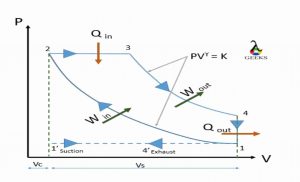
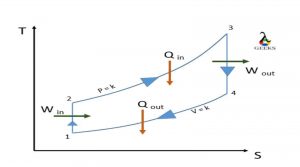
Processes:
1’- 1: suction of Atmospheric air
Atmospheric air is sucked into the cylinder to carry out the compression process. when piston travel in downward direction towards Bottom Dead Center.
system acts as open system.
1-2: Isentropic Adiabatic compression
The piston travels from Bottom of the cylinder (BDC) to Top of the cylinder (TDC), compressing the air adiabatically, keeping entropy constant. No heat heat interaction is taken under consideration. System acts as a closed system.
2-3: Constant pressure heat addition
just before end of compression stroke, fuel is injected with the help of a fuel manifold, and this mixture of fuel with high temperature and high-pressure air makes the fuel to self-ignite (Unlike the petrol engine, Diesel engine doesn’t have spark plug to help combustion process, it has fuel injector is placed to insert the fuel) and releasing the heat in high amount, causing the force at the head of the piston making it move to BDC. This process is carried out under constant pressure. (Actual process is not possible under constant pressure). At a point it acts as a open system as fuel enters the system.
3-4: Isentropic Adiabatic expansion
The piston travels from Top of the cylinder (TDC) to Bottom of the cylinder (BDC) due to the force result of the combustion. And expansion takes place at constant entropy. No heat interaction is taken under consideration.
system acts as a closed system.
4-1-4’: Exhaust of burnt gases
The burnt gas is let out from the exhaust port to make a start for the next cycle. system again acts a open system. we assume the exhaustion process take place at constant volume.
Diesel cycle analysis
1. The piston in the reciprocating engine moves from Top Dead Center to Bottom Dead Center, causing low pressure inside the cylinder. At this point, the inlet port is let open allowing fresh atmospheric oxygen-rich air to enter into the cylinder. The reciprocating system acts as the open system while this process, allowing mass to enter the system.
this process is carried out at a constant pressure (1′-1)
At the end of the suction, the port is closed, and the the system acts as a closed system.
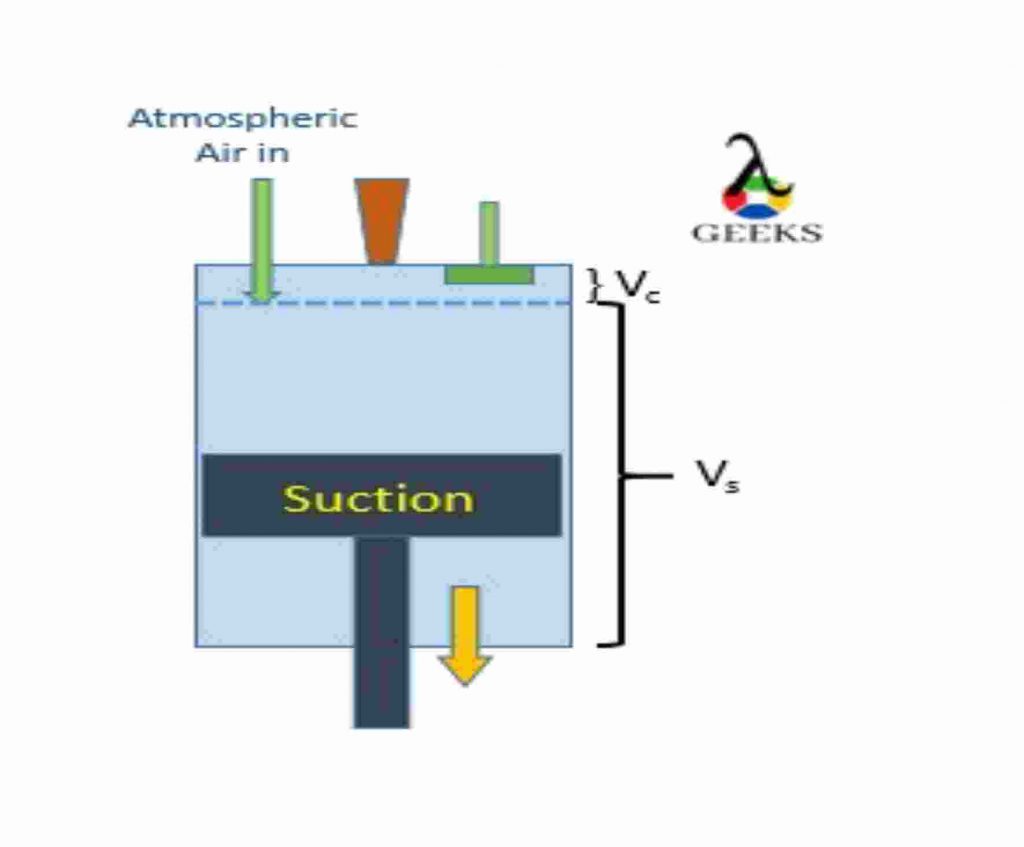
2. The ideal cycle process start when the piston reaches the Bottom Dead Center and starts moving towards Top dead Center.
The reciprocating engine plays as a closed-system. The air inside the cylinder is compressed by the piston. the compression is isentropic-adiabatic compression. (No entropy generation and no heat consideration). As a result of compression, the air reaches high pressure and high temperature.
Before the piston reaches the Top of the cylinder (TDC), the fuel is through the manifold in to the cylinder.
This introduced fuel is in spray form; as the fuel comes in contact with the high pressure and high-temperature environment, it gets self-ignited (No need of spark-plug), causing energy release (Chemical energy is transformed into heat energy).
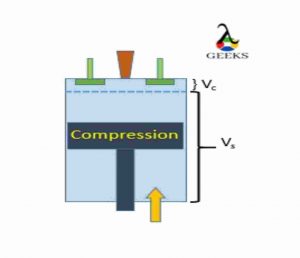
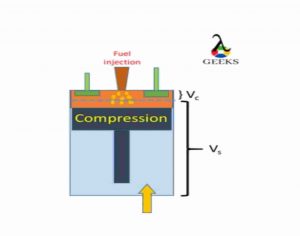
3. The actual power generation takes place at this process; the high force is generated when the combustion takes place, and it forces the piston from Top Dead Center to Bottom Dead Center. The expansion process takes place at this point.
The force is transmitted to run the crankshaft and generate the mechanical energy from the heat energy.
(This stroke is also known as power stroke, in four stroke engine we get one power stroke for every two rotation while in Two stroke we get power power stroke for each rotation.)
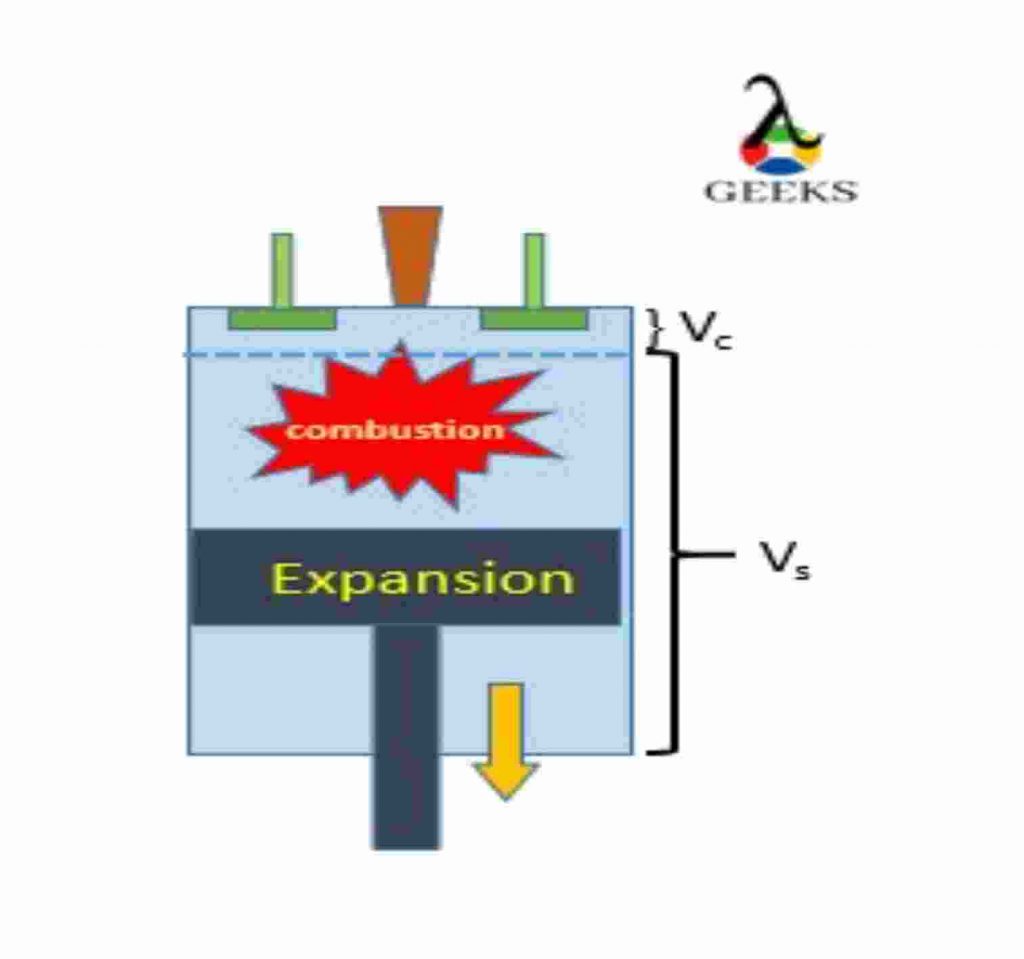
4. Burnt gas (residue) must be let out of the cylinder, hence that work is done by piston by
moving from BDC to TDC
And the one cycle of is completed.
(If reciprocating engine is four stroke each operation take place separately, while for two stoke two operations are performed simultaneously. )
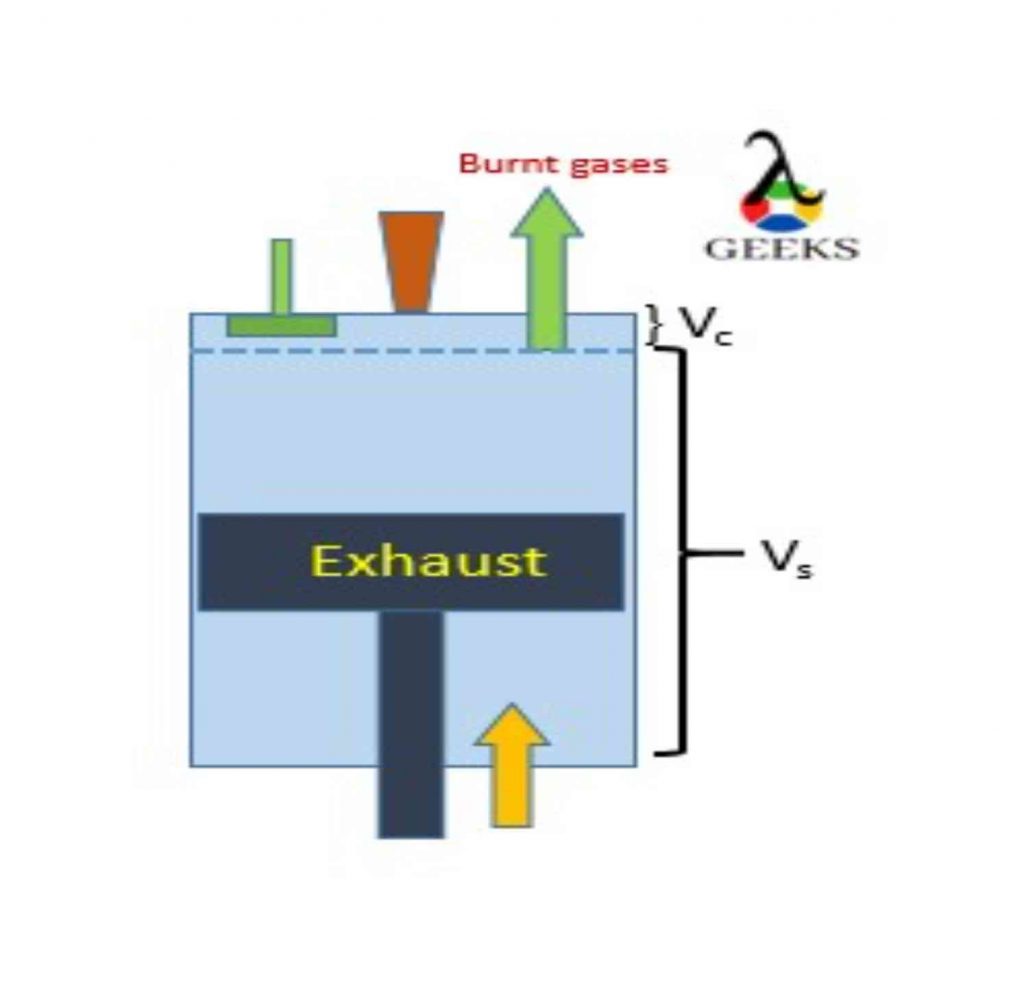
Diesel cycle derivation| diesel cycle formula
Heat Rejected:

Work output:
![]()
![]()
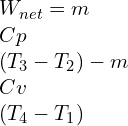
Compression ratio
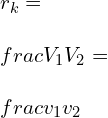
Expansion Ratio
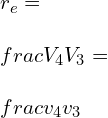
Cut-off ratio:
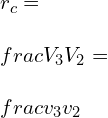
we can corelate the above equation in form as below:
Compression ration can be define as product of expansion ration and cut-off ratio.

Let us see derivation of each individual process:
Process 3-4:
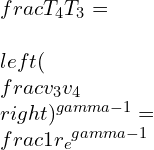
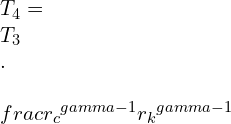
Process 2-3:
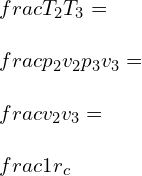

Process 1-2:
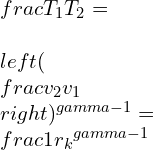
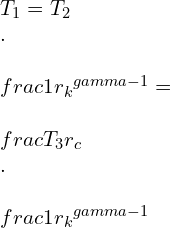
we will further use this temperature values to get efficiency equation.
The efficiency of diesel cycle derivation | diesel cycle efficiency | diesel cycle efficiency derivation | air standard efficiency of diesel cycle | diesel cycle efficiency formula | derivation of diesel cycle efficiency | thermal efficiency of diesel cycle
Efficiency






By substituting T1,T2,T3 in eff enq


Compression ratio of diesel cycle
The compression ratio of the diesel cycle is the ratio of the maximum volume available in the cylinder when the piston is at Bottom Dead Center-(BDC) to the minimum volume available when the piston is at TDC.


Mean effective pressure formula for diesel cycle
Mean effective pressure is the ratio of network-done to the swept-volume
![]()
![]()
Cut off ratio in diesel cycle
The cut-off ratio in the diesel cycle is defined as the ratio of volume after combustion to the volume before combustion.


Semi diesel cycle
Semi diesel cycle, also known as the dual cycle, is the combination of otto and diesel cycles.
In this semi diesel/ dual cycle the heat is added at both constant volume and constants pressure.
( there is simple modification only, the part of heat added is under the constant volume and a remaining part of heat is added at constant pressure)
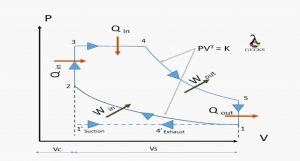
process:
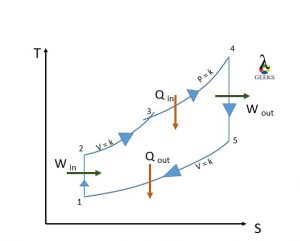
1-2: Isentropic Adiabatic compression:
Air is compressed adiabatically, keep entropy constant and no heat interaction.
2-3: Constant volume Heat addition:
just before the end of compression stroke , that is piston reaches the TDC of cylinder, the fuel is
added and combustion take place at a Isochoric condition, (constant volume).
3-4: Constant pressure Heat addition
A part of combustion is also carried at at constant pressure. and with this heat addition is completed.
4-5: Isentropic Adiabatic expansion
Now, as the high amount of force is generated it pushes piston now and causes the power stroke.
The work output is obtain at this point.
5-6: Constant volume Heat rejection
At the end the burnt gas is let out of the system to make place for fresh supply of air and carry out next cycle.
Two cycle diesel
A two-cycle diesel engine, also known as a two-stroke diesel engine, works similarly to a four-stroke diesel engine. But it gives power stroke for each revolution while a four-stroke engine gives power stroke for two revolutions.
There exists a transfer port inside the cylinder to carry two operations simultaneously.
When the compression takes place, the suction is also taking place.
And when expansion takes place, the input of oxygen-rich air takes place, letting exhaust burn gas out
Simultaneously.
Difference between diesel and otto cycle| diesel vs otto cycle
| Parameters | Diesel cycle | Otto cycle |
| Define | The diesel cycle or Ideal diesel cycle is the power-producing cycle where heat addition takes place at constant pressure. | The Otto cycle is also the ideal power-generating cycle, where heat addition takes place at Isochoric condition (constant volume.) |
| T-S diagram | 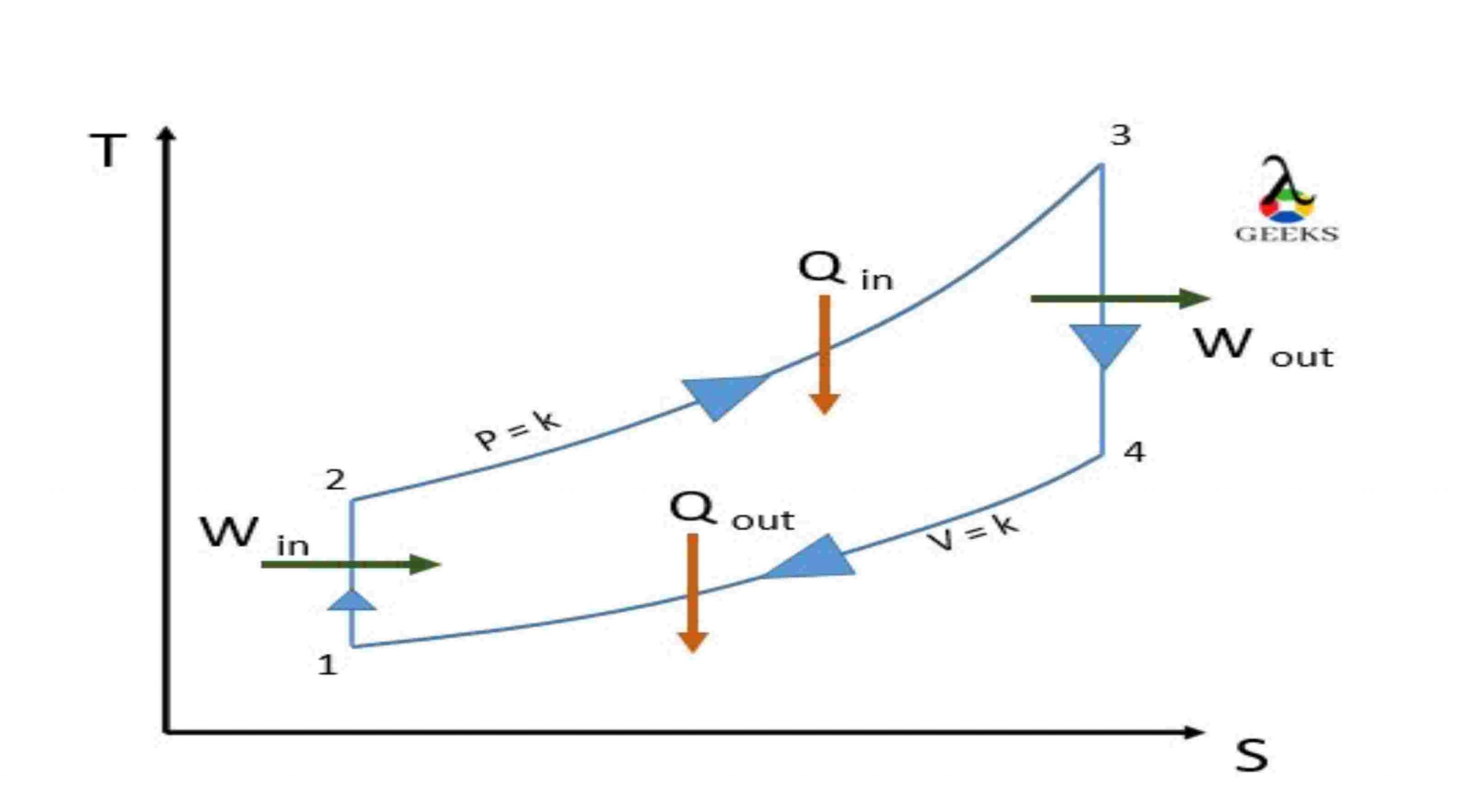 | 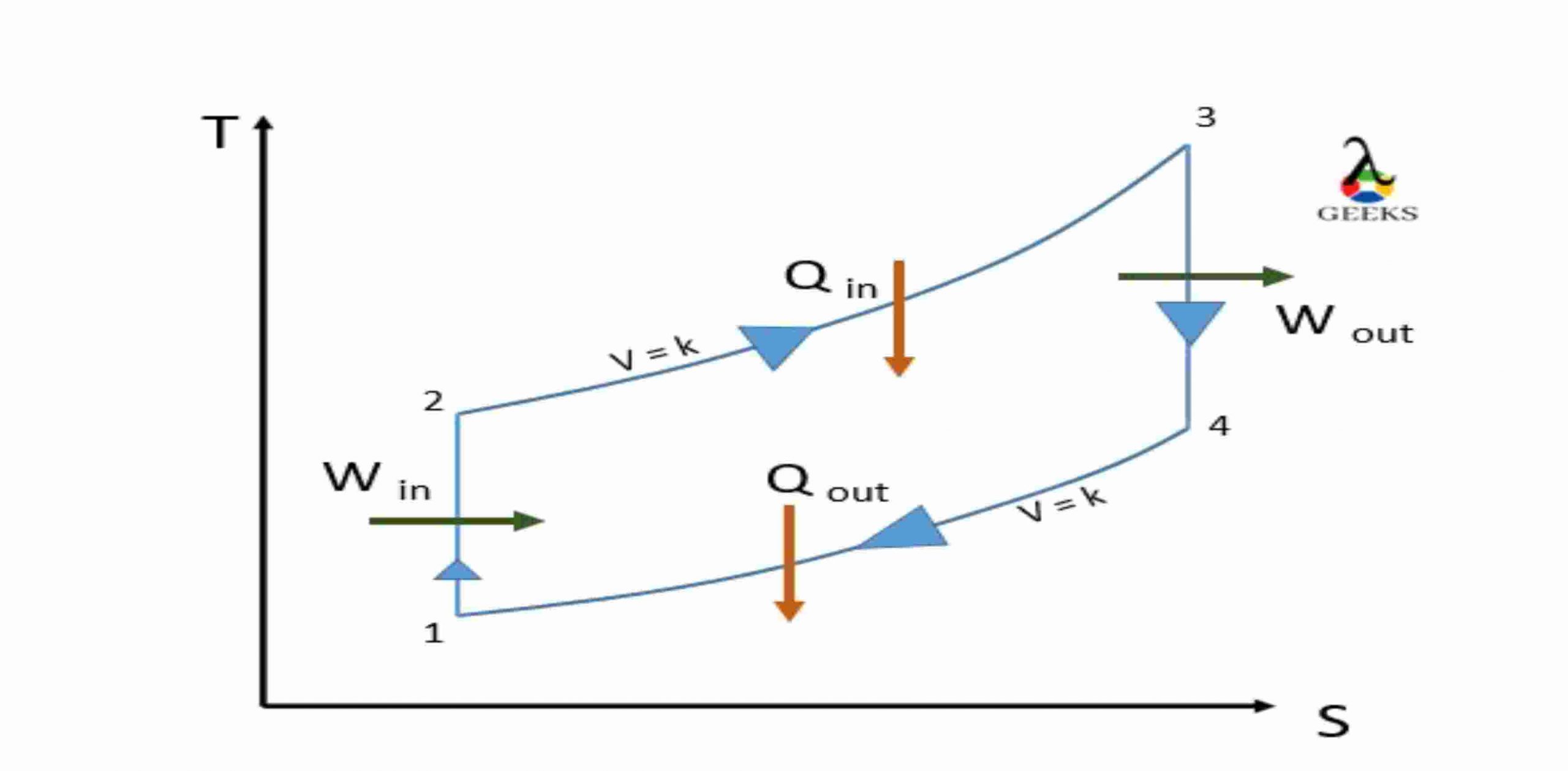 |
| Process | Two isentropic ( 1-2 & 3-4 ) One isobaric heat addition (2-3) One isochoric heat rejection (4-1) | Two isentropic ( 1-2 & 3-4 ) one isochoric heat addition (2-3) one isochoric heat rejection (4-1) |
| Compression ratio | The efficiency of diesel cycle is more as compare to Otto cycle.. | The efficiency of diesel cycle is less as compare to Otto cycle. |
| Same compression ratio | The efficiency of diesel cycle is less as compare to Otto cycle. | The efficiency of diesel cycle is more as compare to Otto cycle. |
| Same maximum pressure | The efficiency of diesel cycle is less as compare to Otto cycle. | The efficiency of diesel cycle is more as compare to Otto cycle. |
| Application | Diesel cycle is used for Diesel/IC engine | Otto cycle is used for Petrol/SI engine |
difference between otto cycle diesel cycle and dual cycle
| Parameters | Diesel cycle | Otto cycle | Dual Cycle |
| Define | The diesel cycle or Ideal diesel cycle is the power-producing cycle where heat addition takes place at constant pressure. | The Otto cycle is also the ideal power-generating cycle, where heat addition takes place at Isochoric condition (constant volume.) | The dual cycle or semi diesel cycle is a combination of the Otto and diesel cycles. In this cycle, the heat is added at both Isochoric condition (constant volume) and isobaric condition (constants pressure.) |
| T-S diagram |  |  | 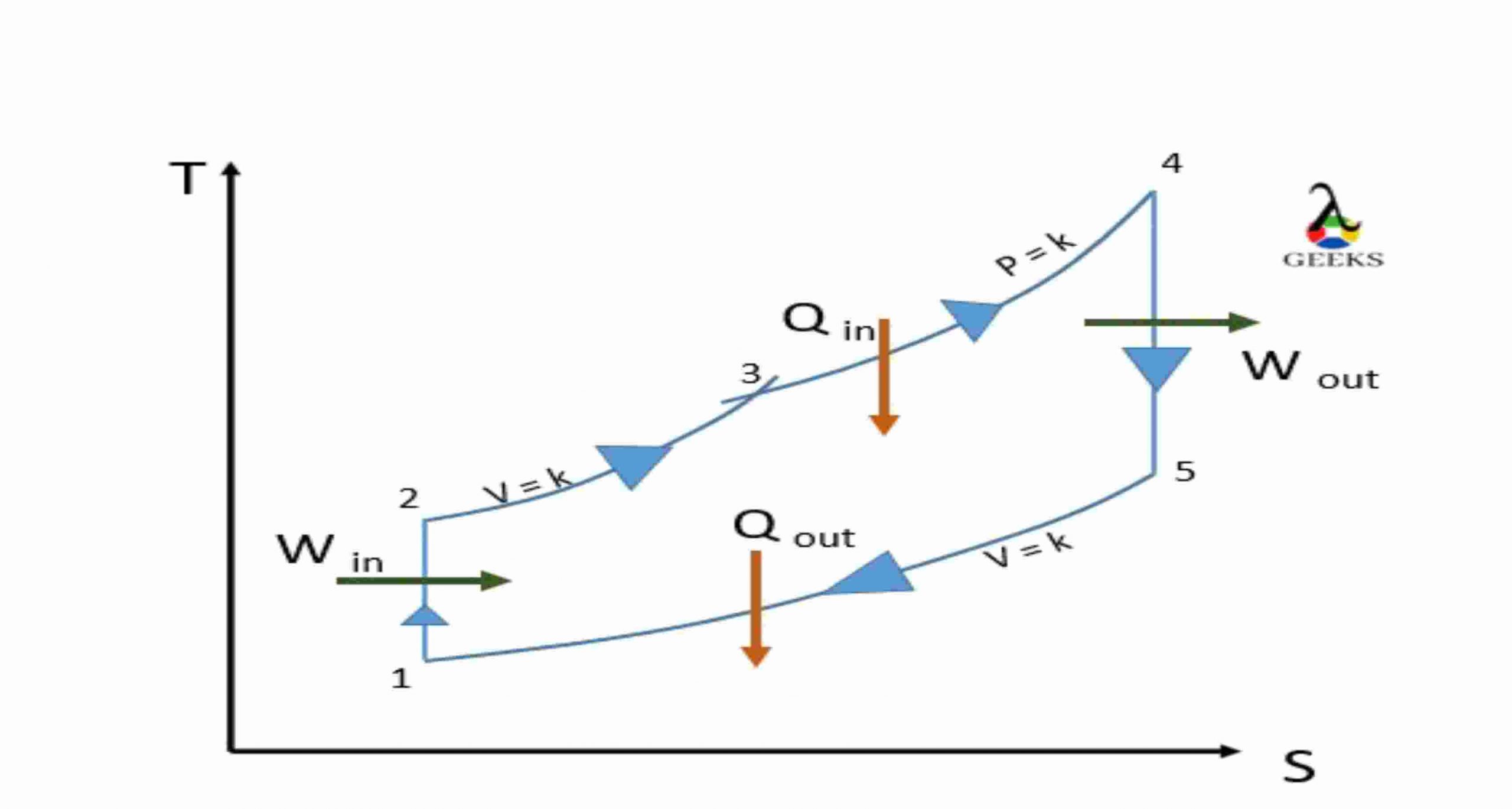 |
| Process | Two isentropic (1-2&3-4 ) One isobaric heat addition (2-3) One isochoric heat rejection (4-1) | Two isentropic (1-2 & 3-4 ) one isochoric heat addition (2-3) one isochoric heat rejection ( 4-1) | Two isentropic ( 1-2 & 4-5 ) One isochoric heat addition(2-3) One isobaric heat addition (3-4) One isochoric heat rejection (4-1) |
| Compression ratio | Compression ratio is 15-20 | Compression ratio is 8-10 | Compression ratio is 14 |
| Same compression ratio | The Efficiency of diesel cycle is more as compare to The Otto cycle. | The Efficiency of diesel cycle is less as compare to The Otto cycle. | The efficiency is between both the cycles (i.e Otto and Diesel) |
| Same maximum pressure | The Efficiency of diesel cycle is less as compare to The Otto cycle. | The Efficiency of diesel cycle is more as compare to The Otto cycle. | The efficiency is between both the cycles (i.e Otto and Diesel) |
| Application | Diesel cycle is used for Diesel/IC engine | Otto cycle is used for Petrol/SI engine | Dual cycle is used for IC engine. |
Application of diesel cycle
Diesel-Internal Combustion engines:
- Automobiles Engines
- Ships and marine applications
- Transport vehicles.
- machinery used for agriculture
- construction equipment and machines
- military and defense
- HVAC
- Power generation
Advantages of diesel engine
New advanced have made diesel engine performance quite good, it is less noisy and has low maintenance cost.
Diesel engine are reliable and robust.
No need of spark-plug , fuel used is of self-igniting nature.
fuel cost is also low as compare to petrol.
diesel cycle sample problems | diesel cycle example | diesel cycle example problems
Q1.With compression ratio of 14, and cut-off at 6% what will be the efficiency of the diesel cycle?
Ans=
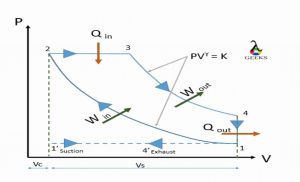
![]()
![]()
![]()
![]()
![]()
Cut-off ratio, ![]()

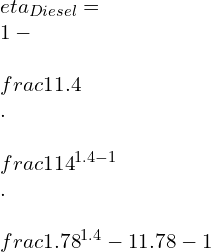

![]() %
%
Q2. Standard diesel cycle with compression ratio of 16, Heat is added at constant pressure of 0.1 MPa. Compression begins at 15 deg Celsius and reaches 1480 deg Celsius at end of combustion.
Find the following:
1. Cut-off ratio
2. Heat added/kg of air
3. Efficiency
4. MEP
Ans=
![]()
T1= 273 + 15 = 288K
p1= 0.1 MPa = 100 KN/m2
T3 = 1480 + 273 = 1735K
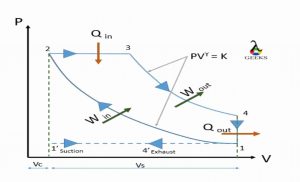
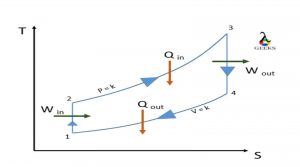

![]()
![]()
(a) Cut-off ratio:

(b) Heat Supplied:
![]()
![]()
![]()
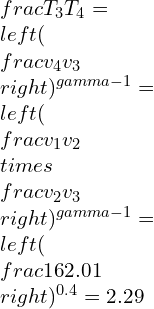

heat rjected,
![]()
![]()
(c) Cycle Efficiency = ![]()
![]() %
%
Also can be determined by;

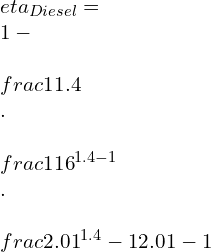

![]() %
%





(d) mean effective pressure (MEP):

FAQs
Otto cycle vs. diesel cycle efficiency
At the same compression ratio: efficiency of diesel cycle is more as compare to Otto cycle.
At same maximum pressure: efficiency of diesel cycle is less more as compare to Otto cycle.
Diesel cycle chart
1’- 1: suction of Atmospheric air
1-2: Adiabatic compression
2-3: Constant pressure heat addition (fuel injection & combustion)
3-4: Adiabatic expansion
4-1-4’: Exhaust of burnt gases
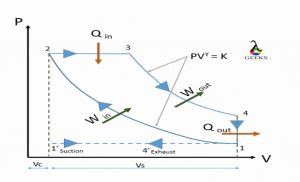
When the efficiency of diesel cycle approaches the Otto cycle efficiency
The efficiency of the diesel cycle approaches the Otto cycle efficiency when the cut-off ratio approaches zero.
Why are engines that use the Diesel cycle able to produce more torque than engines using the Otto cycle
The diesel engine has a greater compression ratio than the Otto cycle engine.
Combustion in the diesel cycle takes place at TDC at the end of the compression stroke and causes the piston to move downward. While in the Otto cycle, engine combustion takes place when the piston is slightly moving towards BDC and contributes to acquire speed.
Diesel fuel is more dense than petrol (used in the Otto cycle), which generates more energy in terms of power.
Also, the size factor does matter; the stroke length and Bore diameter of the Diesel engine is greater than the Otto cycle engine.
Why cant petrol be used in a diesel cycle.
The volatility of petrol is much higher than Diesel; even before completion of the compression stroke, the high pressure will evaporate the fuel.
Hence petrol will ignite in the uncontrolled matter, causing detonation and misfiring.
it will result in damaging of the cylinder hence one should never start the engine if such incidence take place. It is advisable to contact the concern person to remove the petrol form the engine.
Why is the diesel cycle only applicable to large low-speed engines
Diesel cycle uses fuel which is more viscous and power produce in terms of the torques is more.
when we need application of high load we cant use petrol engine as the efficiency will be less for loading condition and will use more fuel.
hence the diesel engine will be beneficial here where the power produce is more at low speed.
for more article related to Mechanical Engineering visit our website.

The lambdageeksScience Core SME Team is a group of experienced subject matter experts from diverse scientific and technical fields including Physics, Chemistry, Technology,Electronics & Electrical Engineering, Automotive, Mechanical Engineering. Our team collaborates to create high-quality, well-researched articles on a wide range of science and technology topics for the lambdageeks.com website.
All Our Senior SME are having more than 7 Years of experience in the respective fields . They are either Working Industry Professionals or assocaited With different Universities. Refer Our Authors Page to get to know About our Core SMEs.